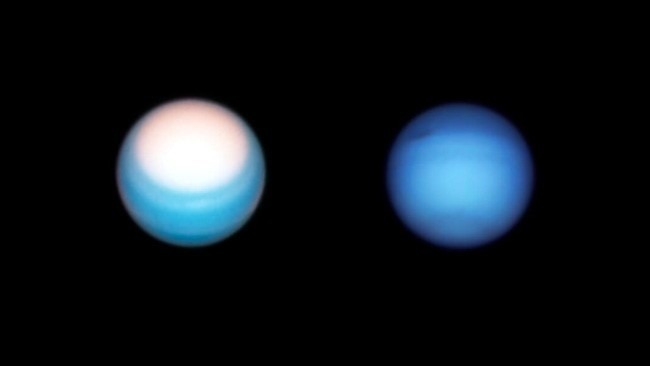| Translate This News In |
|---|
Scientists have discovered why Neptune and Uranus, although being so similar in many aspects, have such differing colours of blue.
Neptune is clearly bluer, whereas Uranus is a light shade of cyan. Although the two planets are identical in mass, size, and atmospheric makeup, Neptune is noticeably bluer than its neighbour.
According to new study headed by Professor Patric Irwin of the Department of Physics at the University of Oxford, the various shades of blue are caused by a hazy layer that exists on both planets. Mr Irwin, the principal author, stated that if it weren’t for the haze, their appearances would be similar.
Researchers created a model to depict aerosol layers in the atmospheres of both planets using observations from the Hubble Space Telescope, NASA’s infrared telescope facility, and the Gemini North Telescope. According to a news release, the model found that excessive haze on Uranus accumulates in the planet’s stagnant, sluggish atmosphere, giving it a lighter hue than Neptune.
Astronomers may now know why Uranus and Neptune are different colours. If you are curious to understand this yourself and find out how observations from @HUBBLE_space contributed to explaining this difference, watch our latest #SpaceSparks episode.
🔗 https://t.co/hr3Bye8Urr pic.twitter.com/eE9FexWg3m
— HUBBLE (@HUBBLE_space) May 31, 2022
“This is the first model to fit reflected sunlight observations from ultraviolet to near-infrared wavelengths at the same time. It’s also the first to explain why Uranus and Neptune have different visible colours “Mr. Irwin explained.
According to the press release, the model has three haze layers of varying heights. The middle layer of haze on Uranus is thicker than on Neptune, affecting the visible colour.
Scientists said that on Uranus, methane ice condenses on particles in the middle layer of haze, forming a shower of methane snow that drags haze particles further into the atmosphere. Once there, the haze particles can induce the condensation of hydrogen sulphide ice, resulting in the formation of a distinct, deeper layer of haze.
Neptune’s atmosphere, on the other hand, is more active and turbulent than Uranus’, implying that it is more efficient at creating snow, which removes more haze and maintains Neptune’s middle layer thinner.
As a result, scientists concluded that Neptune seems bluer, but extra haze on Uranus accumulates in the sluggish atmosphere and causes a lighter colour.


















